
David C Winegar is an author, trainer, coach, speaker, and applied neuroscience advocate who travels the world helping organizations and individuals to achieve more through a better understanding of human behavior. His work has taken him to four continents, coaching 1000 s of people, from more than 90 different countries.
Before getting his MBA in organizational behavior and eBusiness from the University of Pittsburgh, he had an exceptionally diverse work background including; working at the Smithsonian Institution’s American History Museum, in the National Archives as a top-secret records declassification expert, and an International teacher of History and Geography in Helsinki, Finland.
Since receiving his MBA in 1995, he has been in no less than six tech start-up companies, 3 in the US and 3 in Finland, including a forerunner to Twitter and one of the first mobile email services. For the last 11 years, he has been running his organizational development and coaching consulting firm Absolute-North which uses the latest psychological and neuroscience research to develop people.
His first book, The Elevator Pitch of You, uses insights into neuroscience to create a brain-friendly personal brand statement for use in social media and as a tool to build trustful relationships at work. The response to his first book has been overwhelming selling hundreds of copies in the first six months on Amazon, Apple, and Google books.
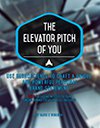
David’s work has been with a broad spectrum of industries, everything from mobile gaming, and SAS companies, to industrial equipment, shipping, and machinery. He has developed an experiential learning method called Artificial Experience Building, which uses neuroscience-backed research to better commit learning to long-term memory.
His practical insights into how to apply neuroscience to your life will provide you with a new set of tools to support you in your persistent pursuit of excellence.
| Profile verified | |
| https://davidcwinegar.com/ | |
| View profile |
Pre-orders
68
Funded
Days left
0
$20 Neuroscience Freaks
23 readers
1 early release professionally produced eBook copy of Brainsights, your name in the "Thank you" credits of my book, plus an invitation to join my online community. The eBook will include live links to the original research and special early access to the online community and discussion forums moderated personally by the author.
Ebook included
$32 Beautiful Print
17 readers
1 full-color beautifully printed copy, inclusion in my "Thank You" page in the book, plus a special early access invitation to join my online community and the forums moderated personally by the author.
Note: The price is a little bit higher than some of the other publishers here because this book will contain full-color images, including original artwork produced by a renowned Finnish watercolor artist. The book has already been sample printed and it is of very high quality and well worth a couple of extra dollars.
1 copy
Free shipping
$50 1 + 1 for the one you Love
2 readers
2 full-color beautifully printed copies, plus 2 eBook copies, inclusion in my "Thank You" page in the book, plus two "early access" invitations to join my online community and access to special content including early release chapters, and special neuroscience insights.
4 copies
Free shipping
$175 VIP Art Lovers Pack!
0 readers
A full color, high quality, print of your choice of any of the 5 original pieces of artworks in the book painted by renowned Finnish watercolorist Kati Immonen - a truely beautiful gift. 1 printed copy of +1 ebook copy, your name in the "Thank You" section of the book and "early access" invitations to join my online community and access to special content including early release chapters, and special neuroscience insights.
1 copy + ebook included
$5 shipping
3 of 3 left
$300 NeuroCoaching + 6
2 readers
10 copies of the book "BraInsights" + a 1/2 day (3.5 hours) of coaching either in person or via video. This is perfect either for a corporate team, a coach and a group of clients, or just a group of friends. Together we will identify the neuroscience theme, (e.g. trust, relationships, teams, conversational intelligence, habits etc.), your name in the "Thank You" section of the book and "early access" invitations to join my online community and access to special content including early release chapters, and special neuroscience insights for the group. A $1750 value.
Please note, the fee does not include travel or accommodations. Delivery will be agreed on after purchase. It is possible to also deliver this virtually at no extra costs.
10 copies + ebook included
Free shipping
8 of 10 left
$1100 Company Performance Booster
0 readers
25 copies of the book "BraInsights" + Your name mentioned as a corporate sponsor in the book + 25 eBook copies + 1 day of free consultation on how to build high-performance teams through psychological-safety, emotional intelligence, and trust. Jump start your corporate performance and help your people understand how to use neuroscience to drive better performance. This is normally a $3500 program, but yours for just $1100 plus you get hard copies and electronic copies of my book.
Please note, the fee does not include travel or accommodations. Delivery will be agreed on after purchase. It is possible to also deliver this virually at no extra costs.
20 copies + ebook included
$10 shipping
5 of 5 left
$1750 Corporate Keynote
0 readers
50 copies of the book "BraInsights" to give away at your next corporate event + an inspirational keynote speech by on insights into how to use neuroscience to re-wire your brain for success. Lifetime access to my neuroscience community site +50 eBook copies of my book "The Elevator Pitch of You: Using neuroscience to craft a unique and powerful personal brand statement." Includes online tool to build a personal brand statement step-by-step. Perfect for helping teams work better together through building better understanding and trust. A $4000 value.
Ebook included
Using neuroscience to live, love, and lead a better life.
Apply the latest neuroscience research to unlock the secrets of your brain and learn to tap into its power to enrich your relationships, improve your wellbeing, and grow your productivity.
Share Post on X Threads LinkedIn Embed| Personal Growth & Self-Improvement Coaching | |
| 50,000 words | |
| 75% complete | |
| 6 publishers interested |
UPDATE: I have had some questions about what happens to the money if I don't get enough people. I now have enough orders that the book will be published and fulfilled. Everyone who has ordered or will order will receive their book. I am still considering publishing partners and will wait until the end of the campaign to make a decision on partners.
Thank you to all who support me- it is very much appreciated. David
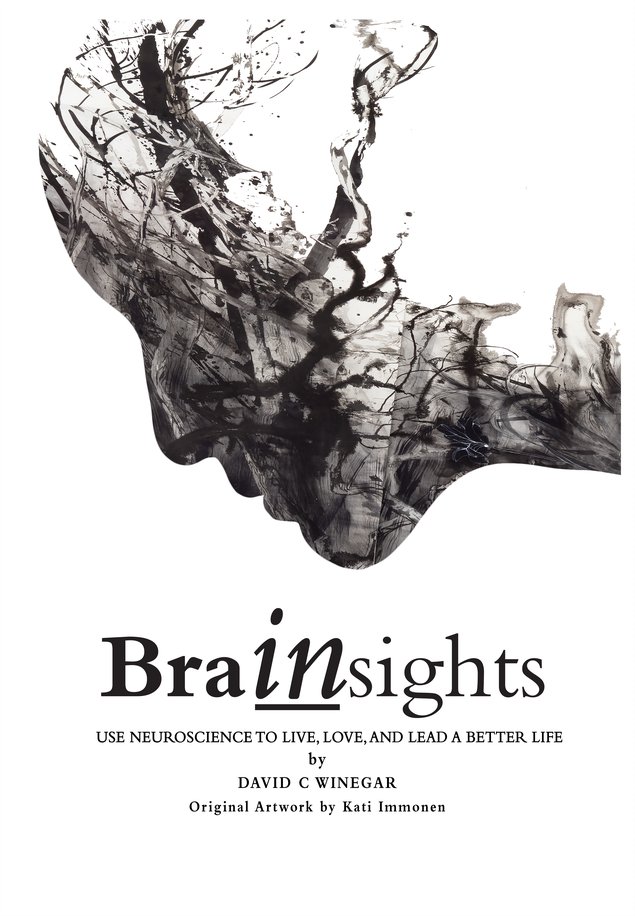
Brainsights will kick open the door to the enigma of our minds by looking at the latest research being carried out by an army of 50 000 neuroscientists. Using that knowledge, I will provide specific strategies to apply it to live, love and lead a better life.
New tools and methods for studying the brain have resulted in an outpouring of insights into human behavior. The science has turned on its head long-held beliefs, leaving us with a more clear understanding of how to influence brain-positive behaviors to promote change. Brainsights will help you to…
I will strip away the inherent complexity of the science and steer you to insights that will enrich your relationships, improve your well being, and grow your productivity.
Brainsights is a thinking person’s self-help book. It is for those that can’t wait to dig into the science, knowing that what awaits them is the wisdom to make a difference in their own lives and those of others.
Well referenced with original research, the book is full of practical insights you can put to use in daily life to rewire yourself for success.
Sections

This audience for this book is divided into three distinct target groups, each with a specific need that is met.
Launch Plan
Keeping the Brain in Mind: Practical Neuroscience for Coaches, Therapists, and Hypnosis Practitioners by Sawn Carson. Changing Mind (April 18, 2014)
The latest revelations from neuroscience can transform the work you do, as a coach, hypnotist, or therapist, in ways that make measurable changes in the brain. This book will teach you how to integrate and utilize the research to explain and empower changes in habituated patterns of thought, feeling and behavior.
Neuroscience for Coaches: How to Use the Latest Insights for the Benefit of Your Clients by Amy Brann. Kogan Page; 2 edition (September 28, 2017)
Many coaching tools and techniques are now fairly well established, but how do they actually work? Neuroscience for Coaches equips coaches with information that will help them answer this question and therefore deliver greater value to clients. Based on over twelve years of research, this book provides a clear explanation of the aspects of neuroscience that are relevant to coaching so you can describe to clients from a neuroscientific perspective why particular techniques and methods work and the benefits to them.
Buddha's Brain: The Practical Neuroscience of Happiness, Love, and Wisdom by Rick Hanson. New Harbinger Publications; 1st edition (November 1, 2009)
If you change your brain, you can change your life. Great teachers like the Buddha, Jesus, Moses, Mohammed, and Gandhi were all born with brains built essentially like anyone else’s—and then they changed their brains in ways that changed the world. Science is now revealing how the flow of thoughts actually sculpts the brain, and more and more, we are learning that it's possible to strengthen positive brain states.
After decades of research, world-renowned Stanford University psychologist Carol S. Dweck, Ph.D., discovered a simple but groundbreaking idea: the power of mindset. In this brilliant book, she shows how success in school, work, sports, the arts, and almost every area of human endeavor can be dramatically influenced by how we think about our talents and abilities. People with a fixed mindset—those who believe that abilities are fixed—are less likely to flourish than those with a growth mindset—those who believe that abilities can be developed. Mindset reveals how great parents, teachers, managers, and athletes can put this idea to use to foster outstanding accomplishment.
The Happiness Advantage: How a Positive Brain Fuels Success in Work and Life by Shawn Achor. Currency; 1 edition (September 14, 2010)
Conventional wisdom holds that if we work hard we will be more successful, and if we are more successful, then we’ll be happy. If we can just find that great job, win that next
promotion, lose those five pounds, happiness will follow. But recent discoveries in the field of positive psychology have shown that this formula is actually backward: Happiness fuels success, not the other way around. When we are positive, our brains become more engaged, creative, motivated, energetic, resilient, and productive at work. This isn’t just an empty mantra. This discovery has been repeatedly borne out by rigorous research in psychology and neuroscience, management studies, and the bottom lines of organizations around the globe.

|
Koehler Books
250 copies • Completed manuscript. Hybrid publisher Commercial Fiction, Contemporary Fiction, Historical Fiction, LGBT Fiction, Literary Fiction, Mystery, Thriller, Horror & Suspense, Mind & Body, Romantic Fiction, Science Fiction & Fantasy, Women's Fiction, YA Fiction, Biography & Memoir, Business & Money, Career & Success, Communication Skills, Corporate Culture, Management & Leadership, Marketing & Sales, Personal Growth & Self-Improvement, Sex & Relationships, Sports & Outdoors, Science Fiction & Humour Worldwide |

|
1106 Design, LLC
Dear Author, Service publisher Children Fiction, Christian Fiction, Commercial Fiction, Contemporary Fiction, Historical Fiction, Literary Essay, Literary Fiction, Mind & Body, Mystery, Thriller, Horror & Suspense, Mythology & Folk Tales, Poetry, Science Fiction & Fantasy, Women's Fiction, YA Fiction, Biography & Memoir, Business & Money, Career & Success, Children Non-Fiction, Christian Non-Fiction, Cookbooks, Food & Wine, Communication Skills, Corporate Culture, Current Affairs, Economics, Education, Entrepreneurship & Small Business, Health, Fitness & Dieting, History, Humor & Entertainment, Journalism, Management & Leadership, Marketing & Sales, Mindfulness & Happiness, Money & Investment, Motivation & Inspiration, Nature & Environment, Parenting, Personal Growth & Self-Improvement, Philosophy, Politics & Social Sciences, Popular Science, Productivity & Time Management, Psychology, Reference, Religion & Spirituality, Science, Sex & Relationships, Society & Culture, Sports & Outdoors, Technology & the Future, Travel, YA Non-Fiction, Science Fiction & Humour Worldwide |

|
Atmosphere Press
250 copies • Partial manuscript. Service publisher Children Fiction, Literary Fiction, Mind & Body, Mystery, Thriller, Horror & Suspense, Romantic Fiction, Science Fiction & Fantasy, YA Fiction, Biography & Memoir, Business & Money, Career & Success, Cookbooks, Food & Wine, Health, Fitness & Dieting, History, Journalism, Personal Growth & Self-Improvement, Politics & Social Sciences, Religion & Spirituality, Science, Society & Culture, Sports & Outdoors, Technology & the Future, Travel Worldwide |

|
Bookmobile
100 copies • Partial manuscript. Service publisher Children Fiction, Literary Fiction, Mind & Body, Mystery, Thriller, Horror & Suspense, Romantic Fiction, Science Fiction & Fantasy, YA Fiction, Biography & Memoir, Business & Money, Career & Success, Cookbooks, Food & Wine, Health, Fitness & Dieting, History, Journalism, Personal Growth & Self-Improvement, Politics & Social Sciences, Religion & Spirituality, Science, Society & Culture, Sports & Outdoors, Technology & the Future, Travel Worldwide |

|
Crescendo Publishing
100 copies • Completed manuscript • Looking for novels, memoirs, fantasy, and other fiction. Service publisher Literary Fiction, Mystery, Thriller, Horror & Suspense, Mind & Body, Romantic Fiction, Science Fiction & Fantasy, YA Fiction, Biography & Memoir, Business & Money, Career & Success, Health, Fitness & Dieting, History, Journalism, Personal Growth & Self-Improvement, Politics & Social Sciences, Society & Culture, Travel Worldwide |
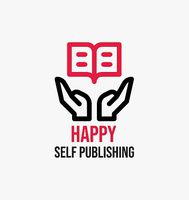
|
Happy Self Publishing
100 copies • Completed manuscript. Service publisher Children Fiction, Literary Fiction, Mind & Body, Mystery, Thriller, Horror & Suspense, Romantic Fiction, Science Fiction & Fantasy, YA Fiction, Biography & Memoir, Business & Money, Career & Success, Cookbooks, Food & Wine, Health, Fitness & Dieting, History, Journalism, Personal Growth & Self-Improvement, Politics & Social Sciences, Religion & Spirituality, Science, Society & Culture, Sports & Outdoors, Technology & the Future, Travel Worldwide |
Dr. Anil Seth from the University of Sussex in the UK is a neuroscientist researching perception and the brain. His research has illuminated how the brain makes assumptions based on our interpretations and experiences. Seth’s study focused on how the brain sees color and what he found was that we interpret color individually.
Have you ever argued with someone about what color something was? I have had this argument with my wife on many occasions. Each of us insisting that a something was a particular color, blue instead of purple, orange instead of pink, and unable to understand why the other just couldn’t see that it was that color. According to Seth, this is not because we are color blind (as my wife tried to insist I was), but because our brains are interpreting color individually.
One of the examples of the brains interpretation of color is a well-known Internet social phenomenon that happened in 2015. Simply known as “the dress” a heated debate ensued about the color of a dress posted in the social media photo platform Tumblr. The dress pictured below, generating more than 73 million views in a matter of days. Was it gold and white or black and blue (which do you see?). (The dress, 2018)

You would think it is a simple question and one that would be far from controversial, but it was a clear demonstration of how our brains individually interpret stimulus.
I was a bit skeptical when I first heard about “the dress” and even found myself wondering, can this be true, is there a visible difference in what people see? There is no doubt in my mind that I see the dress as gold and white. But when I asked my son to tell me what color the dress was, with no other explanation, he immediately replied, it is blue and black. Not only did we both see the dress differently, but the colors were also as different as black and white. I was astounded.
The explanation lies in the research that Dr. Seth carried out on color. He explains the dress is a perfect example of how we each have been programmed to see the world in distinct ways. For our brains, the stimulus we get is only ambiguous electrical signals that require processing to make sense. We do this through something called probabilistic inference where we try to match a new stimulus with prior expectations of what we think it could be.
Our brain combines those prior expectations with signals coming from the outside world to create a “best guess” of what is going on. The brain is always at work desperate to make sense of the noisy and ambiguous flood of sensory information coming in.
The reality is the dress is not white and gold but blue and black. Those of us that see it as white and gold are assuming that we see it in natural sunlight, while the black and blue people think the artificial indoor light is illuminating it. (Seth, 2018) The theory is those who see white and gold have a “sunnier” outlook on life, more positive.
The importance of Seth’s research is to remember each of us has an individual interpretation of the world. We should not assume others see the world the same way as we do. We all interpret what we see based on our stored memories which are a collection of experiences that shape how we view the world.
We also know from neuroscience that there is six times more information flowing back from our thalamus (responsible for sensory interpretation) as we work to make sense of visual information that is coming in. Astoundingly this is proof that our brain is hard at work to make sense of the visual stimuli we are receiving. It is not “recording” what we see and play it back in our heads. Instead, it is taking in the information and using rapid processing it to see if it corresponds with something we already know. To do this is it has to recreate the neural connections that created the pre-existing memory, if it finds a relationship that makes sense, it associates the new stimulus and updates the context.
Another way to understand in practice how our brain interprets and connects to existing stored memory is by looking at our eyes. Our eyes are in continuous motion, moving on average 100 000 times a day, more than 3 times a second. If we wire a video camera to record video according to our eye movement, the result would be a jumpy, blurry, impossible to watch, mess. Why then is our sight not a jumpy, blurry, impossible mess? It is because we use the information already in our brains to create the scene and only update it with new information.
Want to test your brain and see how this works? You can recreate the famous eye movement experiment by Russian psychologist Alfred Lukyanovich Yarbus from 1967. He had people look at a painting and then asked questions about its contents. To simulate this experiment, stop reading and look at the picture below entitled “The Unexpected Visitor.”
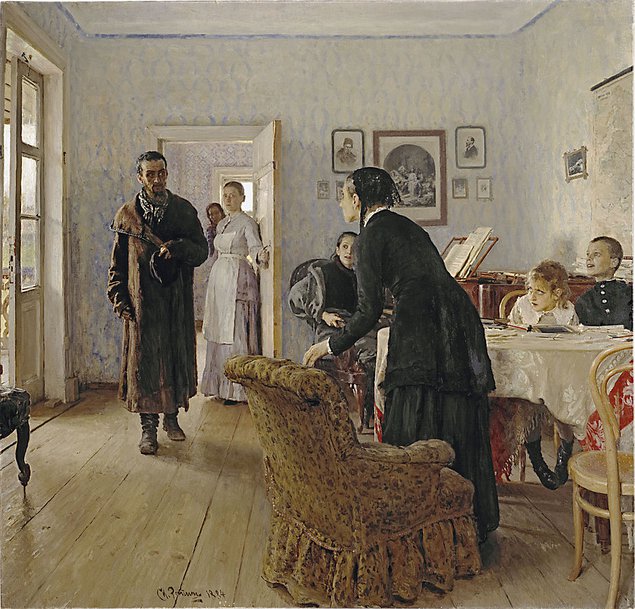 Figure 3 source: Wikimedia Commons
Figure 3 source: Wikimedia Commons
Now hide the image and answer the following question:
1. How many pictures are on the wall?
Now look back at the picture. Were you right? Probably not. I am sure you got it very wrong. Why, because your brain was not primed to look for that information. You were primed to look at the people in the picture. The title, The Unexpected Visitor, primed your brain and focused your eye movements on the people in the room and what they are doing.
Yarbus observed the same when he tracked people’s eyes. Depending on how he primed participants’ eye movements varied. We do not look at all the information coming into our brains from visual stimuli. We must focus that attention to keep our world from being a blurry mess. But this means we also don’t see things as they are, but as our brain expects them to be or as we believe they should be. (Data Deluge, 2012)
As philosopher Herman Helmholtz said; “We remember what we perceive, and we perceive—intuitively or unconsciously--what we remember.”
Think of the implications of how we work with other people. Upbringing, culture, education, the whole gamut of our experiences filter our world to create a unique view of the world. It is not surprising that multinational organizations have a hard time getting people to see the business in the same way.
I have struggled with this for the last 20 years as an expat living in Finland and The Czech Republic. I often find myself asking “why on earth is this done that way here, that makes no sense?” But what doesn’t make sense for me makes a perfect sense for those whose experience and upbringing is different than mine.
An excellent example of this came when I was giving a lecture on leadership to a group of young business students. Part of my presentation was showing pictures painted by leaders from one of my past training programs for a multinational. One of the paintings, depicted by an Italian manager, showed himself standing behind his team as they climbed a mountain. His idea was a leader always stands behind and supports his team. However, a young Finnish male business student interpreted it differently.
He stopped me in the middle of my presentation and asked how that picture was representative of good leadership? He explained that a leader leads from the front. He gave the example of Russian commanders in World War II who stood behind the conscripts shooting any that retreated. He had just completed his mandatory military service, and it was easy to see what was driving his interpretation. It was well reported that the Russians forced their conscripts to fight and had orders from Lenin to shoot any who tried to retreat. For this young Finnish man, the image of standing behind your team only brought up that story of Russian commanders in World War II.
It was not that one had a better view of leadership than the other, each had a valid interpretation and way of looking at the situations. It was the expression of the concept that was fundamentally different, shaped by their experience.
What if that Italian had been the boss of the Finnish man and tasked with explaining his “leadership philosophy” to him? How do you think the Finn would view his boss? Do you start to understand the difficulties and why we struggle to work across cultures? Let me provide a business example that highlights the costs beyond failed relations.
A multinational client I worked for in 2008 had undertaken to open a new factory in mainland China for manufacturing their industrial products. They proceeded to clone the manufacturing plant they had in Northern Europe, which was known for producing high-quality products. They built the factory and started manufacturing. From the first month of production quality problems appeared at an alarming rate. Surprised and perplexed they could not understand how this plant could have so drastically inferior quality to the plant in Europe. The processes and workflow were identical.
The problem was not in the factory design but in the minds of those that worked there. It was explained quite clearly to me a couple of years later by a Chinese manager from the same company who was a participant in one of my leadership programs. He said, for the Chinese, quality is not about over-engineering a product, that is a waste of time and money. Products should meet the minimum level needed for their function. It was how their brains, filtered through their experience, told them to define and interpret quality.
For the company, it meant spending time educating and “rewiring” the brains of the Chinese workers to create a new reality for the workers, one that matched the expectations of their customers. This problem is not limited to this one company. It is an ongoing problem in China. It is, of course, better to understand this brain limitation before the products start rolling off the assembly line than to try to correct it later.
The examples above all seem obvious in hindsight but when in the situation it is more difficult to understand the forces at work that are preventing you from success. But if you train your brain and heighten your awareness of your surroundings, force your brain to process at a higher level those surroundings, that awareness will give you a prediction of a likely future and provide a better indication of how you should act.
The term situational awareness originally was used by aviators and was identified in combat aviation situations as one of the decisive factors to a positive outcome. (Watts, 1996) The elements of situational awareness consist of perception, comprehension, and projection. Together these three factors provide us with a full view of situations and help to guide us in better decision making.
Perception and comprehension are how we become aware of the environment and understand the information coming into our brains. To be fully aware of the situation it is essential to have a high degree of familiarity with the system you are using, put aside assumptions, and keep your mind constantly alert for changes.
To get to this level of understanding, you must fight against your brain which is attempting to take shortcuts and apply mental rules that don’t always provide you with an accurate, current picture of what you are currently experiencing.
The third part, projection, is the ability to project into the future what will happen based on an evaluation of the information received. Being able to anticipate the future and apply reason to direct actions towards outcomes that support us in orchestrating a higher level of success is what we want to achieve.
To become more situationally aware, you need to train and build your experience. It takes a minimum of 2 760 hours of training before a military pilot gets into the cockpit of a fighter plane and another 1 to 2 years of intense training before they are fully competent to enter combat. That is a lot of hours, and most of it is spent in simulation building “artificial experience.”
Most professions do not spend nearly as much time in practice before putting people to work. Most of us are not involved in life or death situations daily, and therefore it can be argued that we don’t need as high a level of situational awareness. But I would say that when we don’t engage in any training, and experience building before we jump in and start doing, the possibilities for wrongly assessing situations multiplies quickly. We end up learning by doing and from our mistakes, the school of “hard knocks.”
We cannot expect that our minds can develop the level of sophistication necessary to understand our limitations in assessing situations, nor how to bypass those limitations to make better decisions, without training. Just as a fighter pilot must train to develop their skills to a level where they can direct a strike force, destroy enemy radar, monitor surface-to-air missiles and track enemy aircraft all while flying at 700 feet per second, you must train to develop your own situational awareness to be able to function at a higher level.
For over 20 years I have been involved in coaching and training people by using artificial experience building methods with the goal of building the database of experiences that they can reference to have a higher level of situational awareness. What I do with my clients is to put them through highly challenging and realistic artificially created experiences.
The background to the method that I developed in my programs came from the US military. When I was just out of college in 1988 I moved to Washington D.C. and worked at the National Archives and Records Administration of the United States in records declassification. I spent my days reading top-secret classified materials and deciding if they could be recommended for declassification. One of the ideas I came across in that work was a method for training battlefield commanders called “artificial experience building.” The way it worked was commanders were put in elaborate simulations on the battlefield and required to make decisions. Those decisions evaluated, and feedback provided. The military psychologists determined that this was highly effective for building combat experience artificially, in a safe environment. Research has found that artificial experience is as valid as real-life experience, therefore when we have new experiences, even if they are artificial, the brain will use that artificially embed experience to evaluate new information.
We use roleplay to create characters and situations that are steeped in emotion and unexpected challenges, purposely raising the stress level and often activating to some degree the flight or fight stressors that lead to poor decisions. After the roleplay has been completed, we take time to evaluate how the situation was approached and what could be improved on. We often then allow the person to “replay” the experience incorporating the feedback, which provides for better internalization of the behavior change needed to have greater success in the situation.
As neuroscientist Gretchen Schmelzer explains, for events to make a lasting change, information must be moved from short-term memory to long-term memory. There are three ways to accomplish this: urgency, repetition, and association. (Schmelzer, 2015)

As we begin the American Thanksgiving …
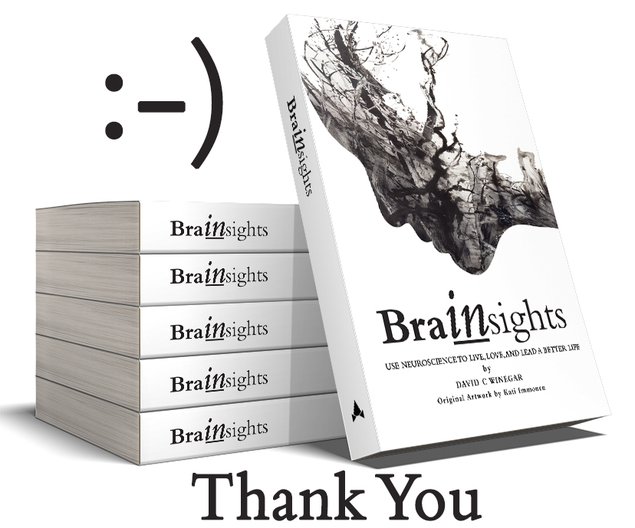
I wanted to say thank you to all the supporters for Brainsights. I very much appreciate your confidence in me and I am looking forward …

One of the things that I wanted to include in the book was original artwork that would serve as a representation of the brain and …
I wanted to thank all of you for your support for my book Brainsights and give you a little preview of what is …
Did it. Ordered one extra
David, This is Leighton. Look forward to reading your book!
Excited to read this book David
I hope you get the book published!
Congratulations!
Good luck!!
Yeah! I can't wait to read it!
All the best, David!
Good luck David! Hamish and Jen Bell
Greetings from your former student (History @ The English School)! Wishing you success with your new book, looking forward to reading it!
I am anxious to get your book and read it. Congratulations David!
Just ordered! Will be interesting to read!
This is a lovely initiative, David. You have my support. Looking forward to reading your work :)
Good luck with the new book David
Hi David, I ordered 3 books, two of them as Christmas presents to my lovely sons. We will spend our Christmas time in Florida, first one week in Weston (Fort Lauderdale and Miami) and next 2,5 weeks in Orlando. So there is plenty of time to read books. Hope to have those books before living Finland the 13th of December. David, I wish you best luck :-)
With kind regards Pirjo Jääskeläinen
Looking forward to reading it!
Good luck with your book.
on Sept. 30, 2018, 10:51 a.m.
Exciting news! Looking forward to this one!